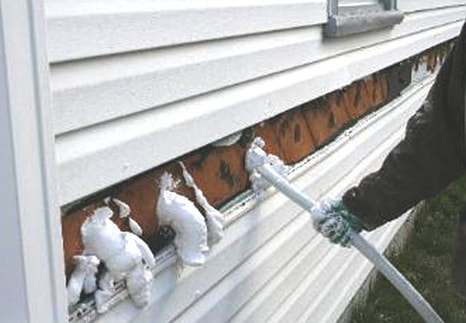|
22/2/2019 0 Comments homesickUrea-formaldehyde foam insulation (UFFI) turned out to be harmless after all. What is UFFI? Urea formaldehyde foam insulation was injected as a mixture of urea formaldehyde resin, an acidic foaming agent and a propellant, such as air. It was commonly installed in older houses by injecting the foam into walls, where it was impractical to provide conventional insulation. Urea formaldehyde foam insulation was approved for use in exterior wood-frame walls only. It has a reasonably good R-value (thermal resistance).
Some formaldehyde gas was released during the on-site mixing and curing. Formaldehyde is colorless, but has a very strong odor, which can generally be detected at concentrations above one part per million. It is this by-product of the curing of the foam that became a controversial issue. Formaldehyde is both a naturally occurring chemical, and an industrial chemical. It is found in dry cleaning chemicals, paper products, no-iron fabrics, diapers, pillow cases, the glue in particle board and plywood, cosmetics, paints, cigarette smoke, and the exhaust from automobiles, gas appliances, fireplaces and wood stoves. It occurs naturally in forests and is a necessary metabolite in our body cells. Ambient formaldehyde levels in houses are typically .03 to .04 parts per million (of air). By comparison, typical levels in the smoking section of a cafeteria are 0.16 ppm. Houses with new carpeting can also reach these levels. The rate at which formaldehyde gases are released from materials depends on temperature and humidity. The higher the humidity levels and the temperature, the more gas is likely to be released. When was UFFI installed? The insulation was used in the 1970’s, most extensively from 1975 to 1978, during the period of the Canadian Home Insulation Program (CHIP), when financial incentives were offered by the government to upgrade home insulation levels. The insulation was banned in December 1980, in Canada. It is estimated that over 100,000 homes in Canada were insulated with UFFI. UFFI was also used in the US during the 70’s, and has been used in Europe over the last thirty years. It is still used in Europe, where it was never banned and is considered one of the better retrofit insulations. In the United States, the Consumer Protection Safety Commission banned the sale of UFFI in 1982, and shortly thereafter a law prohibiting the sale of urea formaldehyde was enacted. In April 1983, the US Court of Appeal struck down the law because there was no substantial evidence clearly linking UFFI to health complaints. UFFI is not widely used in the USA today. Who installed it? UFFI was not a do-it-yourself product. The foam was machine mixed on-site, and injected into wall cavities where it expanded to fill the cavity. Like many new and fast growing industries (particularly those supported by government grants), workmanship and quality control were often less than desirable. What caused the controversy? One of the first problem cases involving formaldehyde was in the US. This involved an extremely air-tight and poorly ventilated mobile home, apparently with a poorly-mixed half-formed UFFI. This started to raise government suspicions about the insulation. (In other mobile home studies, elevated levels of formaldehyde were traced to the panelling or carpets, not UFFI.) A laboratory study which produced nasal cancer in rats that were exposed to high levels of formaldehyde, increased concern. Following some press releases and cautioning by authorities, a number of home owners began to report problems that included respiratory difficulties, eye irritation, running noses, nosebleeds, headaches and fatigue. Few issues have stronger impact than a potential health concern, especially if the suspected cause is new, poorly understood and widely used. In the case of UFFI, the uneasiness and uncertainty were compounded because the material was hidden from sight, and the reported symptoms were identical to those often experienced in our heated, dry indoor air. Although there were no substantial problems clearly attributable to the foam, urea formaldehyde foam insulation was banned as a precautionary measure. Research was initiated to evaluate the problem, and to determine what should be done. No one knew exactly how many homes had UFFI, and it was often difficult to find out whether a home had UFFI. The problem was further complicated by the fact that the foam was often used somewhat inappropriately in walls of solid masonry houses, in attics, in cavities where freeze-up of pipes had occurred, and even as an acoustical insulation in party walls in row houses, and in the ceilings between the first and second floors of houses. The fear of cancer and other health problems were only the beginning of the story. These fears caused a reduction in the value of real estate. The costly "remedial" measures and the long term stigma attached to UFFI houses became a marketplace reality because of perceived health problems. The federal government set guidelines for reducing formaldehyde levels in houses, and removal techniques were specified. The initial threshold level set for formaldehyde gas was 1.0 ppm. As the testing methods improved, the level was brought down to 0.5 ppm and eventually 0.1 ppm. The threshold became very conservative, indeed. A court case which eventually set records was initiated in Quebec, in which the claimants accused the federal government, manufacturers and others of bringing a dangerous material to the market. An interesting twist Those charged with the task of designing and refining remedial measures set out to find the worst cases to test their theories, but they encountered an unexpected problem. They couldn’t find any UFFI insulated houses with formaldehyde levels above 0.1 ppm, let alone 0.5 ppm or 1.0 ppm. Even in the few houses that tested at levels approaching 0.1 ppm, these were rarely duplicated in subsequent testing. It became known that levels of formaldehyde decrease rapidly after the foam has been installed. Within several days of the application, formaldehyde levels typically return to ambient house levels. As the body of information grew, it became clear that finding a single house that exceeded this very conservative threshold level was going to be a challenge. In fact, in reviewing several thousand files, not one house was found with levels of formaldehyde which remained above 0.1 ppm! The highest levels were found in homes with brand new carpeting which were tested on a hot summer day. The same houses tested two weeks later showed levels typical of any house, with or without UFFI. The presence of UFFI does not affect the amount of formaldehyde in the indoor air. Indeed, while not statistically significant, the homes tested were found, on average, to have formaldehyde levels below that of homes of similar ages without UFFI. In a study in Britain, people who worked in environments with high formaldehyde levels, such as morticians and laboratory technicians, were studied for possible health effects. These subjects were found to have a lesss than average number of respiratory diseases, and actually lived slightly longer than average, on the whole. (Again, while this may not be statistically significant, it suggests that low levels of formaldehyde are not harmful.) A number of studies have been done examining the health effects of UFFI. Studies using random samples of UFFI and non-UFFI homes done before the ban showed no impact of UFFI on health. However, studies done after the ban showed increased reporting of symptoms, even for such things as constipation and deafness, which have no biological basis! When no correlation could be found between formaldehyde gas and health problems, other possible problems related to UFFI were investigated. Mould and fungi, dust mites, and un-named "UFFI gases" were all investigated as possibilities. None were linked to UFFI. There was no damage to house framing or materials caused by UFFI. Conclusions UFFI is one of the most thoroughly investigated, and most innocuous building products we have used. After the longest and most expensive civil case ever held in Canada (eight years) was concluded in the Quebec Superior Court, not only was no basis for a settlement found, but the plaintiffs were obliged to pay for most of the costs. The conclusion to be drawn from all this is that urea formaldehyde foam insulation has not been shown to be a health hazard. It is not the purpose of this newsletter to determine why or how all of the controversy arose without any proof. Suffice to say that people with the best intentions were working in the public interest, and perhaps erred on the side of caution. In retrospect, although the results were unfortunate, we would hate to think that people responsible for the health of consumers would err on the other side. We believe that those who have urea formaldehyde foam insulation in their homes should enjoy their houses, and sleep well at night. It is the sincere hope of the authors that the market place will respond appropriately. The owners of properties with this type of insulation should not be penalized financially, and no stigma should be attached to these homes. We would futher urge real estate associations and boards accross Canada to consider dropping the UFFI clause from purchase contracts. Similarly, we would ask mortgage lenders to not penalize those who have UFFI in their homes. UFFI is simply not the problem it was once feared to be. Still concerned? While we do not believe UFFI to be a problem, other household materials and products can produce formaldehyde, and other air pollutants for that matter. If you suspect your indoor air quality to be poor, there are Environmental Consultants listed in the Yellow Pages of your phone book. Article courtesy Carson Dunlop and Associates, Toronto, Ontario
0 Comments
Leave a Reply. |
AuthorGil Strachan is a professional home inspector, representing Electrospec Home Inspection Services in east-central Ontario since 1994. CategoriesAll Appliances Buying And Selling Cooling Electrical Environmental Exterior Health And Safety Heating Home Improvement Home Inspection Insulation Insurance Interior Plumbing Roofing Special Structure Archives
January 2024
|


